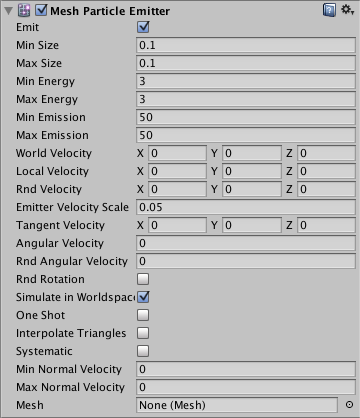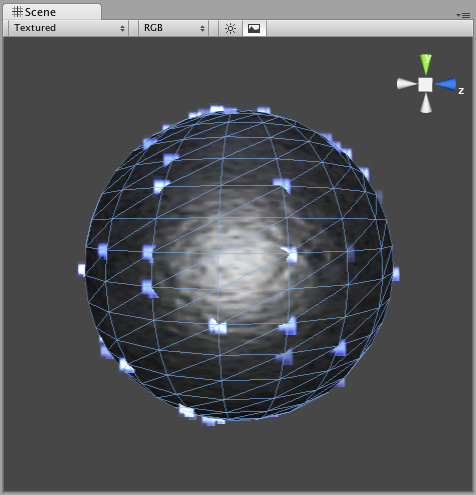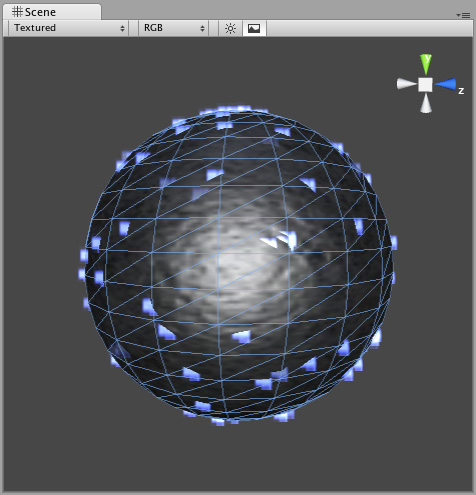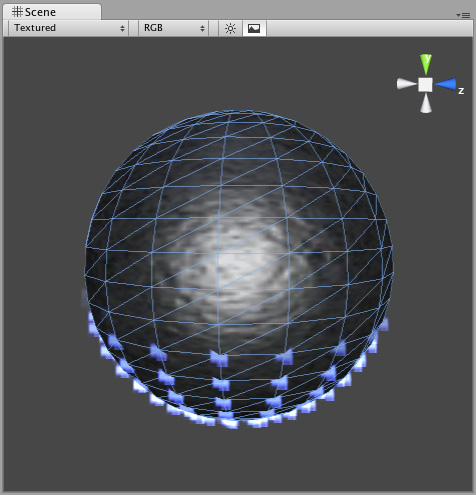Mesh Particle Emitter (Legacy)
The Mesh Particle Emitter emits particles around a meshThe main graphics primitive of Unity. Meshes make up a large part of your 3D worlds. Unity supports triangulated or Quadrangulated polygon meshes. Nurbs, Nurms, Subdiv surfaces must be converted to polygons. More info
See in Glossary. Particles are spawned from the surface of the mesh, which can be necessary when you want to make your particles interact in a complex way with objects.

Properties
| Property: | Function: |
|---|---|
| Emit | If enabled, the emitter will emit particles. |
| Min Size | The minimum size each particle can be at the time when it is spawned. |
| Max Size | The maximum size each particle can be at the time when it is spawned. |
| Min Energy | The minimum lifetime of each particle, measured in seconds. |
| Max Energy | The maximum lifetime of each particle, measured in seconds. |
| Min Emission | The minimum number of particles that will be spawned every second. |
| Max Emission | The maximum number of particles that will be spawned every second. |
| World Velocity | The starting speed of particles in world space, along X, Y, and Z. |
| Local Velocity | The starting speed of particles along X, Y, and Z, measured in the object’s orientation. |
| Rnd Velocity | A random speed along X, Y, and Z that is added to the velocity. |
| Emitter Velocity Scale | The amount of the emitter’s speed that the particles inherit. |
| Tangent Velocity | The starting speed of particles along X, Y, and Z, across the Emitter’s surface. |
| Angular Velocity | The angular velocity of new particles in degrees per second. |
| Rnd Angular Velocity | A random angular velocity modifier for new particles. |
| Rnd Rotation | If enabled, the particles will be spawned with random rotations. |
| Simulate In World Space | If enabled, the particles don’t move when the emitter moves. If false, when you move the emitter, the particles follow it around. |
| One Shot | If enabled, the particle numbers specified by min & max emission is spawned all at once. If disabled, the particles are generated in a long stream. |
| Interpolate Triangles | If enabled, particles are spawned all over the mesh’s surface. If disabled, particles are only spawned from the mesh’s vertrices. |
| Systematic | If enabled, particles are spawned in the order of the vertices defined in the mesh. Although you seldom have direct control over vertex order in meshes, most 3D modelling applications have a very systematic setup when using primitives. It is important that the mesh contains no faces in order for this to work. |
| Min Normal Velocity | Minimum amount that particles are thrown away from the mesh. |
| Max Normal Velocity | Maximum amount that particles are thrown away from the mesh. |
Details
Mesh Particle Emitters (MPEs) are used when you want more precise control over the spawn position & directions than the simpler Ellipsoid Particle Emitter gives you. They can be used for making advanced effects.
MPEs work by emitting particles at the vertices of the attached mesh. Therefore, the areas of your mesh that are more dense with polygons will be more dense with particle emission.
Particle Emitters work in conjunction with Particle Animators and Particle Renderers to create, manipulate, and display Particle SystemsA component that simulates fluid entities such as liquids, clouds and flames by generating and animating large numbers of small 2D images in the scene. More info
See in Glossary. All three Components must be present on an object before the particles will behave correctly. When particles are being emitted, all different velocities are added together to create the final velocity.
Spawning Properties
Spawning properties like Size, Energy, Emission, and VelocityA vector that defines the speed and direction of motion of a Rigidbody
See in Glossary will give your particle system distinct personality when trying to achieve different effects. Having a small Size could simulate fireflies or stars in the sky. A large Size could simulate dust clouds in a musky old building.
Energy and Emission will control how long your particles remain onscreen and how many particles can appear at any one time. For example, a rocket might have high Emission to simulate density of smoke, and high Energy to simulate the slow dispersion of smoke into the air.
Velocity will control how your particles move. You might want to change your Velocity in scripting to achieve interesting effects, or if you want to simulate a constant effect like wind, set your X and Z Velocity to make your particles blow away.
Simulate in World Space
If this is disabled, the position of each individual particle will always translate relative to the Position of the emitter. When the emitter moves, the particles will move along with it. If you have Simulate in World Space enabled, particles will not be affected by the translation of the emitter. For example, if you have a fireball that is spurting flames that rise, the flames will be spawned and float up in space as the fireball gets further away. If Simulate in World Space is disabled, those same flames will move across the screen along with the fireball.
Emitter Velocity Scale
This property will only apply if Simulate in World Space is enabled.
If this property is set to 1, the particles will inherit the exact translation of the emitter at the time they are spawned. If it is set to 2, the particles will inherit double the emitter’s translation when they are spawned. 3 is triple the translation, etc.
One Shot
One Shot emitters will create all particles within the Emission property all at once, and cease to emit particles over time. Here are some examples of different particle system uses with One Shot Enabled or Disabled:
Enabled:
- Explosion
- Water splash
- Magic spell
Disabled:
- Gun barrel smoke
- Wind effect
- Waterfall
Interpolate Triangles
Enabling your emitter to Interpolate Triangles will allow particles to be spawned between the mesh’s vertices. This option is off by default, so particles will only be spawned at the vertices.

Enabling this option will spawn particles on and in-between vertices, essentially all over the mesh’s surface (seen below).

It bears repeating that even with Interpolate Triangles enabled, particles will still be denser in areas of your mesh that are more dense with polygons.
Systematic
Enabling Systematic will cause your particles to be spawned in your mesh’s vertex order. The vertex order is set by your 3D modeling application.

Normal Velocity
Normal Velocity controls the speed at which particles are emitted along the normal from where they are spawned.
For example, create a Mesh Particle System, use a cube mesh as the emitter, enable Interpolate Triangles, and set Normal Velocity Min and Max to 1. You will now see the particles emit from the faces of the cube in a straight line.
See Also
Hints
- Be careful of using many large particles. This can seriously hinder performance on low-level machines. Always try to use the minimum number of particles to attain an effect.
- The Emit property works in conjunction with the AutoDestruct property of the Particle Animator. Through scripting, you can cease the emitter from emitting, and then AutoDestruct will automatically destroy the Particle System and the GameObjectThe fundamental object in Unity scenes, which can represent characters, props, scenery, cameras, waypoints, and more. A GameObject’s functionality is defined by the Components attached to it. More info
See in Glossary it is attached to. - MPEs can also be used to make glow from a lot of lamps placed in a sceneA Scene contains the environments and menus of your game. Think of each unique Scene file as a unique level. In each Scene, you place your environments, obstacles, and decorations, essentially designing and building your game in pieces. More info
See in Glossary. Simply make a mesh with one vertex in the center of each lamp, and build an MPE from that with a halo material. Great for evil sci-fi worlds.